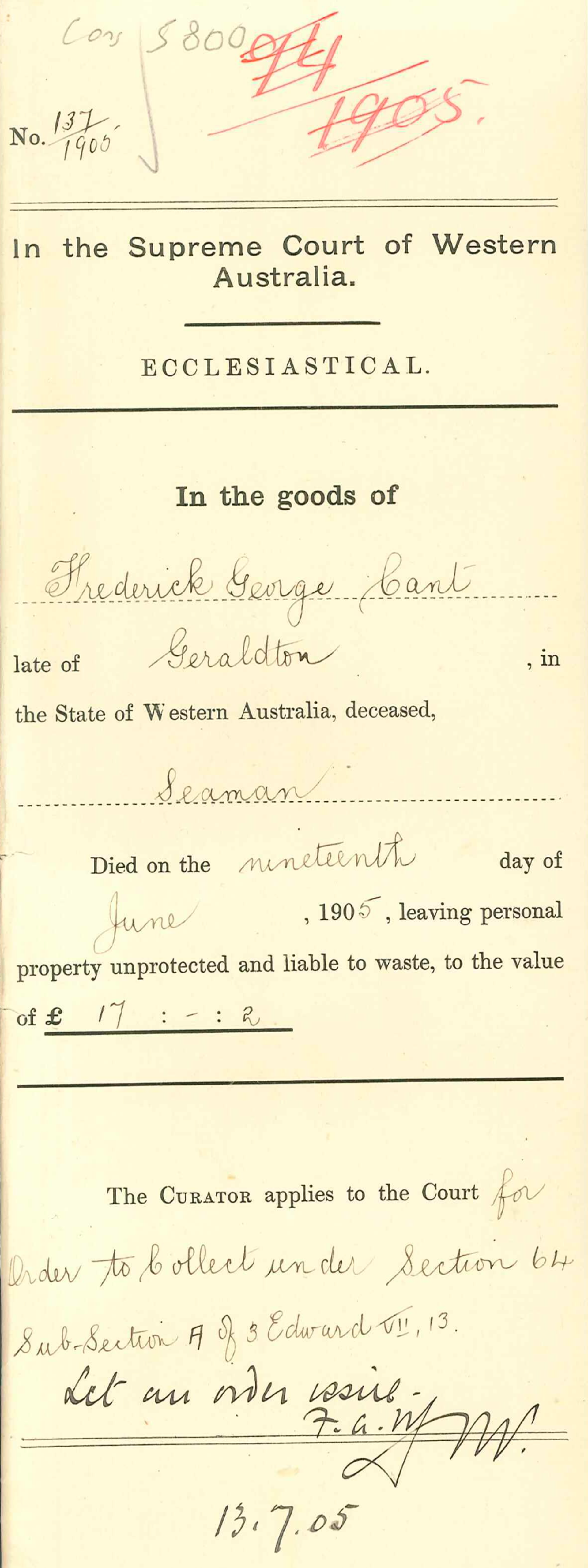George Frederick Cant
Vessel Name: Era
George Frederick Cant
Drowned in Geraldton Harbour; Body recovered
19 June 1905

George Frederick Cant Probate Papers
The Era was originally built as an 80-foot racing yacht by G. Gibbs in 1887 for Alfred George Milson of Sydney, at a cost of £5000. Despite a very successful racing career, it was later purchased by Charles Nelson on behalf of Winter, Brandt & Co. of Geraldton. It was sailed in full racing trim by Nelson to Fremantle. The voyage took only 21 days arriving on 5 April of 1905. One of the conditions of the sale was that the Era be taken out of eastern state waters, as Milson could not bear to see it converted into a fishing boat. Winter, Brandt & Co had a habit of purchasing racing yachts from the East Coast, and repurposing them for fishing. The Iduna, Magnolia, Jennet, Sea Queen and Wanderer were all of that pedigree and all owned at some time by the Company.
The purchase cost of the Era is said to have been recovered from the sale of its luxury fittings. The ketch was then used as a mother ship to smaller fishing boats at Shark Bay, taking their catch to markets in Geraldton and Fremantle. Its great spread of canvas enabled the boat to often cover the distance from Fremantle to Geraldton in 23 hours, with a full load of fish onboard.
Upon first arriving in Fremantle the Era’s large counter stern was cut off reducing her length to 68 feet, the interior stripped, and a 16000 pound capacity icebox installed. Once the refit was complete they departed for Geraldton and arrived on Sunday 18 June 1905. The following afternoon all four of her crew went ashore to visit the local watering holes. The crew consisted of;
Charles Nelson, Captain
Newton Watt, Fisherman
William Jones, Cook
George Frederick Cant, Able Seaman
George Frederick Cant was one of the original crew on the Era that shipped with Nelson from Sydney on its 21 day trip to Fremantle, employed as an Able Seaman. Interestingly, the Captain knew him only as Frederick “Carter”.
Cant said he was short of money and Jones lent him a pound. The crew first visited the Victoria Hotel and the Shamrock Hotel for a drink and then returned to the Jetty, intending to return aboard the Era. Cant proposed another drink at the Geraldton Hotel and the crew agreed. Cant was drinking whiskey that night. After that they all went aboard using the dinghy they had moored at the old jetty. They sat in the cabin talking for a bit. When Nelson went to sleep he saw Cant sitting in the cabin with his coat and hat off. They had all spent the evening in a friendly way. At 3am Nelson got up and noticed Cant was not in his bunk. Nelson considered he might be for’ard where he sometimes slept. In the morning they noticed he was missing, his coat was lying in his bunk, but there was no trace of him. After searching the boat they reported the matter to Police at 9am. The dinghy was fast astern just as they had left it. Nelson felt he had not been affected by the liquor he had drunk when they went aboard, and had not known him to suffer with fits. He was also not known to sleep walk. Jones testified that in total, Cant had seven drinks in the course of the evening.
Dragging operations were promptly initiated by Water-police constable Evenson between the two jetties, but initially without success. The corpse was eventually located by pouring a few bottles of oil on the sea in the vicinity of where the Era was anchored, making the surface smooth and the objects on the bottom distinguishable. He later found the body at 11:15am on Thursday 22 June. The body was lying on its back, with the arms slightly raised, in about 12 feet of water. It was dressed in trousers, vest, shirt and boots. Dr. Hungerford, R.M.O, gave a detailed description of his post mortem findings;
“He was a well-developed man, and had most of his clothing on. The exposed part of his skin had been eaten away so that his features were unrecognisable. All his clothes were buttoned, nothing being disarranged. On opening the chest, the lungs were found in the usual condition of a drowned person. The stomach had a thick fluid in it, partially undigested food, and even smelt strongly of spirits. There were no external marks of violence. There were tattoo marks on the left hand and left forearm. I considered the death was due to asphyxia caused by drowning.”
An enquiry into the death was opened at Geraldton Courthouse before Mr. Walter, R.M., and a jury. They returned a verdict that George Frederick Cant came to his death by drowning. The property of Cant included a book, and in conjunction with the tattoo marks proved the deceased’s name was Cant, not Carter. Cant had no reason for deserting the ship, and there was a sum of nearly £30 owing to him for wages. He was a native of England and about 38 years of age. He left behind a wife, Beatrice May in Brightlingsea in Essex, and four young children.
